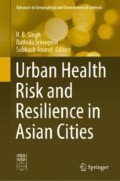Abstract
Urban population in India is increasing at a very rapid pace. The number of metropolitan cities with a population of one million and above steadily increased from 5 in 1951 to 35 in 2001 and 53 in 2011. The urban areas work as engines of growth that create skills and wealth for the nation and generate employment for the migrants from the rural areas. Mobility is a very crucial factor for the economic growth of urban areas. Although the cities are growing at a great pace, the carrying capacity of the roads is very limited. The number of vehicles in urban areas are increasing, resulting in the slowing down of vehicular speed, unbearable pollution (air and noise) and increase in the number of road accidents. This has resulted in immense suffering for the commuters who face an ordeal travelling to and from their workplace. So, there is an urgent need to focus on the issue of providing an adequate transport system. Keeping this in mind, this paper aims to assess the importance of the role of the urban rapid mass transit system in context of sustainable urban development by analyzing data from the Annual Report of Delhi Metro Rail Corporation. The study also examines the performance of Delhi Metro and tries to explore its impact on the urban life of Delhi. Finally, the paper brings to the fore that Delhi Metro has a great impact in the reduction of road accidents, pollution level, vehicles taken out off-road and traffic congestion in Delhi.
Access this chapter
Tax calculation will be finalised at checkout
Purchases are for personal use only
Notes
- 1.
Kolkata Metro Rail Corporation Limited.
- 2.
Business Standard India; (21 September 2016) “324 km of metro rail operational in India now, says Venkaiah Naidu”.
- 3.
Delhi Metro Rail Corporation Limited.
- 4.
Census of India, 2011.
- 5.
- 6.
- 7.
- 8.
References
Acharya SR, Morichi S (2007) Motorization and role of mass rapid transit in East Asian megacities. IATSS Res l31(2)
Advani M, Tiwari G (2005) Evaluation of public transport system: case study of Delhi metro. Transport Research and Injury Prevention Programme, Indian Institute of Technology, Delhi
Annual Report, Delhi Metro (2013–14) Delhi Metro Rail Corporation
Annual Report, Delhi Metro (2015–16) Delhi Metro Rail Corporation
Badami MG, Haider M (2007) An analysis of public bus transit performance in Indian cities. Transp Res Part A: Policy Pract 41(10):961–981
Breithupt M, Wangner A et al (2010) Challenges of urban transport in developing countries- a summary. Transport Policy Advisory Services, GTZ
Fatal Accidents in Delhi (2010–2014) Ministry of Home Affairs, Government of India. Indiastat.com
Goel D, Gupta S (2015) Delhi Metro and air pollution. Department of Economics, Delhi School of Economics
Halcrow F (2000) World Bank urban transport strategy review- mass rapid transit in developing countries. Department for International Development, Halcrow Group Limited, London
Indian Express (2015) Delhi Metro keeps 3.9 lakhs vehicles off road in 2014
Javier P (2004) Mass rapid transit system and urban land spatial interaction and impacts: case study of LRT-1 metro Manila. Philippines, International Institute for Geo- Information Science and Earth Observation
Jha SK (2013) Road safety in Delhi: acritical analysis of the role of Public Institutions. International Institute of Social Sciences, The Hague, Netherlands
Kochi Metro Project Report (2011) Delhi Metro Rail Corporation
Lin Luan (2014) A short history of world metro systems-in pictures. The Rockefeller Foundation. https://www.theguardian.com/cities/gallery/2014/sep/10/-sp-history-metro-pictures-london-underground-new-york-beijing-seoul
Mittal T (2015) Smart urban mobility: road less travelled. Indian Institute of Management, Bangalore
Murty MN, Dhavala KK et al (2006) Social cost- benefit analysis of Delhi Metro. Institute of Economic Growth, Delhi, India. http://mpra.ub.uni-muenchen.de/1658/
Nallathiga R (2011) Mass urban transportation in Indian cities: features of three models and learnings. In: Asian urbanization conference, Hyderabad
Phil F (2013) Mass rapid transit systems for cities in the developing world. Transp Rev, 2003, 23(3):299–310
Sabharwal S, Goel M (2011) Delhi Metro: a solution to the problem of congestion and pollution in the modern city like Delhi. Int J Bus Econ Manag Res
Sharma N, Singh A et al (2014) Emission reduction from MRTS projects: a case study of Delhi Metro. Atmos Pollut Res 5:721–728
SocialCops (2016) How sustainable and successful is the Delhi Metro?
State-wise Annual Average Level of Pollutants, 2009–2011 under National Air Quality Measure Program (NAMP), Ministry of Statistics and Programme Implementation. Indiastat.com
The Hindu (2015) Impact of Public Transport on Delhi
Total Number of Persons Killed in Road Accidents Per 10,000 Vehicles (2009–2011) Ministry of Road Transport and Highways, Government of India. Indiastat.com
Wright L, Fjellstrom K (2003) Sustainable transport: a sourcebook for policy-makers in developing cities. Module 3a: Mass Transit Options, GTZ
Author information
Authors and Affiliations
Corresponding author
Editor information
Editors and Affiliations
Rights and permissions
Copyright information
© 2020 Springer Nature Singapore Pte Ltd.
About this chapter
Cite this chapter
Kumari, M., Banerjee, A. (2020). Evaluation of Mass Rapid Transit System (MRTS): A Case Study of Delhi. In: Singh, R., Srinagesh, B., Anand, S. (eds) Urban Health Risk and Resilience in Asian Cities. Advances in Geographical and Environmental Sciences. Springer, Singapore. https://doi.org/10.1007/978-981-15-1205-6_19
Download citation
DOI: https://doi.org/10.1007/978-981-15-1205-6_19
Published:
Publisher Name: Springer, Singapore
Print ISBN: 978-981-15-1204-9
Online ISBN: 978-981-15-1205-6
eBook Packages: Earth and Environmental ScienceEarth and Environmental Science (R0)

